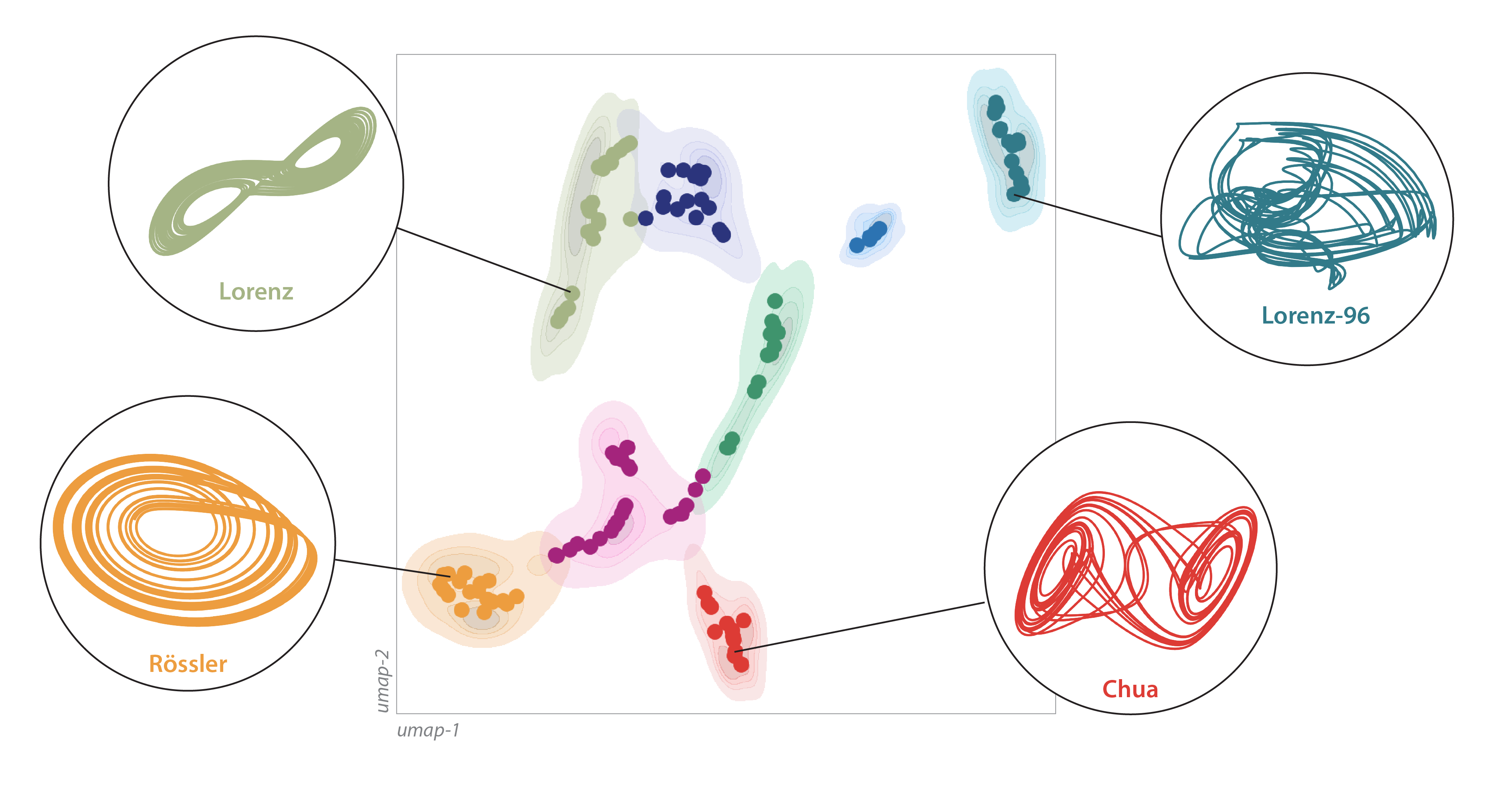dysts
Analyze more than a hundred chaotic systems, including the Rayleigh-Plesset system.
To see the figure generated in benchmarks/figure_descriptive_statistics.ipynb:
- install dependencies in requirements
- remove degas
- add to
TimeSeriesDataset("../dysts/data/large_univariate__pts_per_period_100__periods_100.json")
Basic Usage
Import a model and run a simulation with default initial conditions and parameter values
from dysts.flows import Lorenz
model = Lorenz()
sol = model.make_trajectory(1000)
# plt.plot(sol[:, 0], sol[:, 1])Modify a model's parameter values and re-integrate
model = Lorenz()
model.gamma = 1
model.ic = [0.1, 0.0, 5]
sol = model.make_trajectory(1000)
# plt.plot(sol[:, 0], sol[:, 1])Load a precomputed trajectory for the model
eq = Lorenz()
sol = eq.load_trajectory(subsets="test", noise=False, granularity="fine")
# plt.plot(sol[:, 0], sol[:, 1])Integrate new trajectories from all 131 132 chaotic systems with a custom granularity
from dysts.base import make_trajectory_ensemble
all_out = make_trajectory_ensemble(100, resample=True, pts_per_period=75)Load a precomputed collection of time series from all 131 132 chaotic systems
from dysts.datasets import load_dataset
data = load_dataset(subsets="train", data_format="numpy", standardize=True)Additional functionality and examples can be found in the demonstrations notebook.. The full API documentation can be found here.
Reference
For additional details, please see the preprint. If using this code for published work, please consider citing the paper.
William Gilpin. "Chaos as an interpretable benchmark for forecasting and data-driven modelling" Advances in Neural Information Processing Systems (NeurIPS) 2021 https://arxiv.org/abs/2110.05266
We are very grateful for any suggestions or contributions. See CONTRIBUTING.md
Installation
This is a forked version. The installation instructions below refer to the original repository.
Install from PyPI
pip install dysts
To obtain the latest version, including new features and bug fixes, download and install the project repository directly from GitHub
git clone https://github.com/williamgilpin/dysts
cd dysts
pip install -I .
Test that everything is working
python -m unittest
Alternatively, to use this as a regular package without downloading the full repository, install directly from GitHub
pip install git+https://github.com/williamgilpin/dysts
The key dependencies are
- Python 3+
- numpy
- scipy
- pandas
- sdeint (optional, but required for stochastic dynamics)
- numba (optional, but speeds up generation of trajectories)
These additional optional dependencies are needed to reproduce some portions of this repository, such as benchmarking experiments and estimation of invariant properties of each dynamical system:
- nolds (used for calculating the correlation dimension)
- darts (used for forecasting benchmarks)
- sktime (used for classification benchmarks)
- tsfresh (used for statistical quantity extraction)
- pytorch (used for neural network benchmarks)
- sympy (used for equation analysis benchmarks)
Benchmarks
The benchmarks reported in our preprint can be found in benchmarks. An overview of the contents of the directory can be found in BENCHMARKS.md, while individual task areas are summarized in corresponding Jupyter Notebooks within the top level of the directory.
Contents
- Code to generate benchmark forecasting and training experiments are included in
benchmarks - Pre-computed time series with training and test partitions are included in
data - The raw definitions metadata for all chaotic systems are included in the database file
chaotic_attractors. The Python implementations of differential equations can be found inthe flows module
Implementation Notes
- Currently there are
131132 continuous time models, including several delay differential equations. There is also a separate module with 10 discrete maps, which is currently being expanded. - The right hand side of each dynamical equation is compiled using
numba, wherever possible. Ensembles of trajectories are vectorized where needed. - Attractor names, default parameter values, references, and other metadata are stored in parse-able JSON database files. Parameter values are based on standard or published values, and default initial conditions were generated by running each model until the moments of the autocorrelation function all become stationary.
- The default integration step is stored in each continuous-time model's
dtfield. This integration timestep was chosen based on the highest significant frequency observed in the power spectrum, with significance being determined relative to random phase surrogates. Theperiodfield contains the timescale associated with the dominant frequency in each system's power spectrum. When using themodel.make_trajectory()method with the optional settingresample=True, integration is performed at the defaultdt. The integrated trajectory is then resampled based on theperiod. The resulting trajectories will have consistent dominant timescales across models, despite having different integration timesteps.
Acknowledgements
- Two existing collections of named systems can be found on the webpages of Jürgen Meier and J. C. Sprott. The current version of
dystscontains all systems from both collections. - Several of the analysis routines (such as calculation of the correlation dimension) use the library nolds. If re-using the fractal dimension code that depends on
nolds, please be sure to credit that library and heed its license. The Lyapunov exponent calculation is based on the QR factorization approach used by Wolf et al 1985 and Eckmann et al 1986, with implementation details adapted from conventions in the Julia library DynamicalSystems.jl
Ethics & Reporting
Dataset datasheets and metadata are reported using the dataset documentation guidelines described in Gebru et al 2018; please see our preprint for a full dataset datasheet and other information. We note that all datasets included here are mathematical in nature, and do not contain human or clinical observations. If any users become aware of unintended ethics or trademark issues that may arise due to the use of this data, we encourage reporting them by submitting an issue on this repository.
